|
Germany wears its riches well: elegant big-city charm, picture-postcard small towns, pagan-inspired harvest festivals, a wealth of art and culture and the perennial pleasures of huge tracts of forest, delightful castles and fine wine and beer are all there for the enjoying. Germany's reunification in 1990 was the beginning of yet another chapter in Germany's complex history. No visitor will remain untouched by this country's past and the way it affects the nation today.
The Swan Prince
 This is King Ludwig's magnificent and most famous castle, built in the neo-late romanesque style. With its turrets and mock-medievalism, its interior styles ranging from Byzantine through Romanesque to Gothic its a real fairy-tale fantasy come true. It was built between 1869 and 1886 for the Bavarian King Ludwig II. A splendid and imaginative "fairy-tale castle" high above the Alpsee lake with the Alps towering above it. This is King Ludwig's magnificent and most famous castle, built in the neo-late romanesque style. With its turrets and mock-medievalism, its interior styles ranging from Byzantine through Romanesque to Gothic its a real fairy-tale fantasy come true. It was built between 1869 and 1886 for the Bavarian King Ludwig II. A splendid and imaginative "fairy-tale castle" high above the Alpsee lake with the Alps towering above it.
Only about a third of the building was actually completed. The 15 rooms you see on the tour show astonishing craftsmanship and richness of detail. Woodcarving in Ludwig's bedroom took 14 carpenters 4 1/2 years to complete. Wagner's operas feature everywhere in the form of murals.
The best view of the castle and a 45m waterfall is from the nearby Mary's Bridge (Marienbruecke), which spans a deep gorge. On the path between this bridge and the castle is a wonderful view of Hohenschwangau and the Alpsee.
Guided tours take about 35 minutes. You have to walk 170 steps up and down, a lift is not available. The castle (like Hohenschwangau) is open daily April to October, 8.30-5.30, November to March 10-4.
OKTOBERFEST IN MUNICH
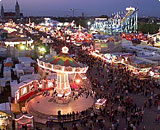 Most Oktoberfests in the United State try to emulate, even in a small way, or for at least to cash in on the name, of the most famous Oktoberfest in the world. The Munich Oktoberfest is the largest German "Volksfest" (folk festival) and the only one bearing the name "Oktoberfest" which functions somewhat like a trademark. It promises the world's biggest good-time affair, attended by millions of thirsty souls from all over the globe, and takes place on the "Theresienwiese" with its giant beer tents, where buxom beer maidens serve the precious brew by the liter in large steins, where thirty-piece Bavarian bands rock the thick air, and where there's no end to singing "them old time drinking songs."
Most Oktoberfests in the United State try to emulate, even in a small way, or for at least to cash in on the name, of the most famous Oktoberfest in the world. The Munich Oktoberfest is the largest German "Volksfest" (folk festival) and the only one bearing the name "Oktoberfest" which functions somewhat like a trademark. It promises the world's biggest good-time affair, attended by millions of thirsty souls from all over the globe, and takes place on the "Theresienwiese" with its giant beer tents, where buxom beer maidens serve the precious brew by the liter in large steins, where thirty-piece Bavarian bands rock the thick air, and where there's no end to singing "them old time drinking songs."
The first Oktoberfest was actually part of a marriage celebration when, in October of 1810, Bavarian King Max Joseph gave a big time wedding for Crown Prince Ludwig, later to become King Ludwig I, with the Princess Therese von Sachsen-Hildburghausen. It culminated with a series of horse races and gave rise to the tradition of the October festival, and in the following year, became an annual affair commemorating this grand wedding forevermore. The Oktoberfest we know today, evolved over time and incorporated a number of different traditions.
In the 18th century, horse races, once so popular, were disappearing. Franz Baumgartner, corporal of the national garde, horse lover and owner of a good race horse himself, thought of a way to revive the races. Why not make horse races a part of the marriage celebration! The story goes that one Major Andrä Dall'Armi was designated to lead a delegation of officers of the Guard to suggest it to the King. King Max Joseph was delighted.
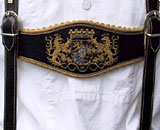 Five days after the royal wedding, on October 17, a festival including the horse races, was held on the meadow in front of the Sendlinger Tor, one of Munich's many gates. The royal family, the royal court and the city magistrate were present and the citizens of Munich were invited to attend the festivities. The festival was such a success that it was decided to repeat the horse races in the following year. The Guard cavalry is said to have celebrated accordingly and requested that the race grounds be named "Theresienwiese" in honor of the crown princess. With this began that part of the Oktoberfest tradition--the present-day location--referred to as "d' Wies'n" (the meadow). In 1811 a big agricultural fair was added to the races and by 1818 the first performers and beer pub owners participated. Though the horse races were removed in 1938, many other traditions survived, which made the "Oktoberfest" not only a tourist attraction, but also a door to learning something about the German region of Bavaria and its people.
Five days after the royal wedding, on October 17, a festival including the horse races, was held on the meadow in front of the Sendlinger Tor, one of Munich's many gates. The royal family, the royal court and the city magistrate were present and the citizens of Munich were invited to attend the festivities. The festival was such a success that it was decided to repeat the horse races in the following year. The Guard cavalry is said to have celebrated accordingly and requested that the race grounds be named "Theresienwiese" in honor of the crown princess. With this began that part of the Oktoberfest tradition--the present-day location--referred to as "d' Wies'n" (the meadow). In 1811 a big agricultural fair was added to the races and by 1818 the first performers and beer pub owners participated. Though the horse races were removed in 1938, many other traditions survived, which made the "Oktoberfest" not only a tourist attraction, but also a door to learning something about the German region of Bavaria and its people.
The Oktoberfest is now celebrated in September, because the chilly Bavarian October winds blowing from the Alps, can surprise with an early cold and snow. The 16-day Fest always starts on a Saturday in September and ends on the 1st Sunday in October. Over time certain rituals evolved which are followed from year to year.
For the Opening day ceremonies, promptly at 11 a.m. a parade enters the grounds on the Wies'n headed by the Münchner Kindl--the little Munich city's coat of arms. The mayor arrives in a festive coach followed by civic dignitaries and horse-drawn brewer's carts decorated with flowers. This colorful ceremony with elaborate floats, beer bands and men, women and children wearing traditional costumes (lederhosen and dirndls) dates back to 1887. More than 7,0000 people participate in the four-mile long parade.
Don't miss it!
HISTORY
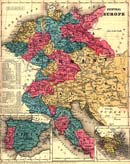 Unsurprisingly for a country whose land has so often been at history's crux, the moods and preoccupations of Germany's people are reflected in a rich artistic heritage: from the claustrophobic beauty of its cathedrals to classical films from the silent era of cinema, from the most influential philosophers (try Kant, Hegel, Nietzsche and Marx for starters) to some of the world's great physicists (Einstein and Planck), from the cream of classical composers (Bach, Beethoven, Brahms, Handel and Wagner) to contemporary industrial-grunge music and Krautrock, from the genius of Goethe to the revolutionary theatre of Brecht, Germany has it all. The scope of German art is such that it could be the focus of an entire visit.
Unsurprisingly for a country whose land has so often been at history's crux, the moods and preoccupations of Germany's people are reflected in a rich artistic heritage: from the claustrophobic beauty of its cathedrals to classical films from the silent era of cinema, from the most influential philosophers (try Kant, Hegel, Nietzsche and Marx for starters) to some of the world's great physicists (Einstein and Planck), from the cream of classical composers (Bach, Beethoven, Brahms, Handel and Wagner) to contemporary industrial-grunge music and Krautrock, from the genius of Goethe to the revolutionary theatre of Brecht, Germany has it all. The scope of German art is such that it could be the focus of an entire visit.
Arguably the finest artist Germany has produced, Johann Wolfgang von Goethe (1749-1832) was a poet, dramatist, painter, scientist and philosopher. His greatest work, the drama Faust, is a masterful epic of all that went before him, as the archetypal human strives for meaning. The ghost of Goethe inhabits the soul of Germany. Germany has also been endowed with many exceptional visual artists. The gothic sculpture of Peter Vischer and his sons, the renaissance portraiture of Albrecht Dürer and the baroque architecture of Balthasar Neumann are all magnificent examples in their fields. A steadfast commitment to excellence in artistry persists in more recent forms, with Germany a notable producer of excellent and challenging cinema from Rainer Werner Fassbinder and Werner Herzog, among others.
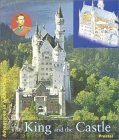 Germany's artistic diet, rich though it is, has nothing on its food. This is traditionally a meat-and-potatoes kind of country. Though vegetarian and health-conscious restaurants are starting to sprout, it's best to stop counting calories and cholesterol levels while in Germany. The assault begins with a good German breakfast: rolls, jam, cheese, cold meats, hard-boiled egg and coffee or tea. To be fair, many Germans have switched to lighter breakfasts like cornflakes or muesli, but visitors can still be served the traditional cut meat and jam. Lunch is the main meal of the day, but breakfast is so big you'd be forgiven for just picking up a midday bratwurst from the ubiquitous Imbiss (takeaway-food stand). Dinner is allegedly a lighter meal, but this can still mean a plate full of sausages and dumplings. (Light eaters may want to opt for international cuisine from Germany's immigrant communities.) Beer is the national beverage and it's one cultural phenomenon that must be adequately explored. The beer is excellent and relatively cheap. Each region and brewery produces beer with a distinctive taste and body. Impromptu visits to small breweries are better than adding your bulk to the already crowded festivals like Munich's Oktoberfest. In winter, you can experience the glorious haze induced by Glühwein, a hot, spicy mulled wine guaranteed to take the chill away.
Germany's artistic diet, rich though it is, has nothing on its food. This is traditionally a meat-and-potatoes kind of country. Though vegetarian and health-conscious restaurants are starting to sprout, it's best to stop counting calories and cholesterol levels while in Germany. The assault begins with a good German breakfast: rolls, jam, cheese, cold meats, hard-boiled egg and coffee or tea. To be fair, many Germans have switched to lighter breakfasts like cornflakes or muesli, but visitors can still be served the traditional cut meat and jam. Lunch is the main meal of the day, but breakfast is so big you'd be forgiven for just picking up a midday bratwurst from the ubiquitous Imbiss (takeaway-food stand). Dinner is allegedly a lighter meal, but this can still mean a plate full of sausages and dumplings. (Light eaters may want to opt for international cuisine from Germany's immigrant communities.) Beer is the national beverage and it's one cultural phenomenon that must be adequately explored. The beer is excellent and relatively cheap. Each region and brewery produces beer with a distinctive taste and body. Impromptu visits to small breweries are better than adding your bulk to the already crowded festivals like Munich's Oktoberfest. In winter, you can experience the glorious haze induced by Glühwein, a hot, spicy mulled wine guaranteed to take the chill away.
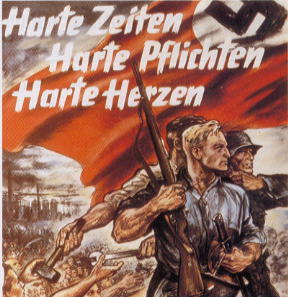 Germany's hill-and-trough history kicked in early: from the time that everyone's favourite fossils, the Neanderthals, left their jaw-jutting remains in the Neander Valley near Düsseldorf, this joint has been in the thick of it. All of Europe's great empires got their paws into Germany, but none was ever able to count all its inhabitants as faithful subjects. Different pockets of fierce resistance met the Roman legions (50 BC to the 5th century AD), the Frankish conqueror, Charlemagne (up to the early 9th century), and Otto the Great's Holy Roman Empire (from late in the 10th century). By the time the house of Habsburg, ruling from Vienna, took control in the 13th century it was little more than a conglomerate of German-speaking states run by parochial princes.
Germany's hill-and-trough history kicked in early: from the time that everyone's favourite fossils, the Neanderthals, left their jaw-jutting remains in the Neander Valley near Düsseldorf, this joint has been in the thick of it. All of Europe's great empires got their paws into Germany, but none was ever able to count all its inhabitants as faithful subjects. Different pockets of fierce resistance met the Roman legions (50 BC to the 5th century AD), the Frankish conqueror, Charlemagne (up to the early 9th century), and Otto the Great's Holy Roman Empire (from late in the 10th century). By the time the house of Habsburg, ruling from Vienna, took control in the 13th century it was little more than a conglomerate of German-speaking states run by parochial princes.
The Habsburgs muddled on until the devastating Thirty Years War (1618-48), sparked by ongoing religious and nationalist conflicts. Europe had been simmering ever since 1517 when Martin Luther tacked 95 suggestions for improved service to his local church door in Wittenburg. It took a bloody good stoush to settle everyone down and secure the rights of both Protestants and Catholics. Germany lost a third of its population in the process. Local princes assumed complete sovereignty over a patchwork of some 300 states, which made it all too easy for Napoleon to come along in the early 19th century and start adding them to his scrapbook. The French never quite managed to subdue Prussia, which became the centre of German resistance. It was Prussia that led the 1813 war that put an end to Napoleon's German aspirations in a decisive battle at Leipzig. In 1866 Otto von Bismarck, chancellor of Prussia, annexed most of Germany, consolidating his position as biggest wig in Europe with a resounding victory over France in 1871. The Prussian king, Wilhelm I, was instated as Kaiser and a united Germany hit the world stage for the first time.
Wilhelm II dismissed Bismarck in 1890, lingered long enough to lead Germany into WWI, then snuck off to Holland in 1918 when he realised war wasn't going to end in a ticker-tape parade. Germany struggled with civil unrest and a disastrous peace, uniting only in dislike of the reigning Weimar Republic. Then came Adolf Hitler, an Austrian drifter and German army veteran who was able to turn general disaffection into a focussed lunacy. In 1933 his National Socialist German Worker's (or Nazi) Party assumed ultimate authority over Germany. Extravagant military spending and blasé border bending gave way to outright aggression, WWII, and the unrivalled horror of the Holocaust. Even the Germans were surprised by the success of their initial invasions, but by 1943 a litany of heavy losses set the tone for the sluggish march to 1945's unconditional surrender.
Postwar Germany was divided up between the Allies, with Britain, France and the USA consolidating the western portion into the Federal Republic of Germany, and the Soviet zone transmogrifying into the communist German Democratic Republic. This formula for division was repeated in Berlin. West Germany received massive injections of US capital, attracting many workers from the miserable economic conditions in the East until some bright spark had the idea of building a wall around West Berlin and sealing the rest of the border. The Cold War's icy eye focussed on Berlin. Over the next 25 years West Germany became one of the world's most prosperous nations while its communist Siamese sibling suffered. The collapse of communism in Eastern Europe has no more poignant symbol than the opening of the Berlin frontier. That was one of world history's better parties at the Berlin Wall in late 1989.
As a result of the reunification of Germany, the Helmut Kohl era was recorded as one of the most dramatic periods in the country's history. After 16 years, however, it came to an end when a coalition of Social Democrats and Greens took office in 1998. Two years later, an investigation was launched which uncovered that Kohl and his conservative Christian Democratic Union party had operated a slush-fund in defiance of the German constitution.
Today's united Germany has its problems, but the social dislocation which was widely forecast has been minimal. Although the euphoria of reunification has subsided, and there is some resentment and disaffection from both sides, Germany is working towards true unity in typically sedulous fashion. The extreme right wing, although insidious and occasionally violent, is politically weak. Germany has absorbed the majority of refugees from the former Yugoslavia, and these and other immigrants are targets of renewed racist attacks.
BERLIN
Since the Reunification in 1990, Berlin has undergone a process of continual redefinition and change. This richness, created from the injection of the new into a potent historical structure, has become one of Germany's and Europe's premiere cultural attractions.
The restored identity as the nation's capital has been a driving force in both urban design and cultural diversity. Berlin is now world-famous for its international architecture, fine and performing arts
|



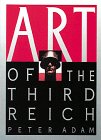
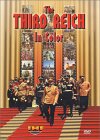



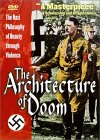


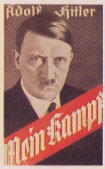



 View movies
View movies




